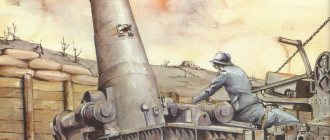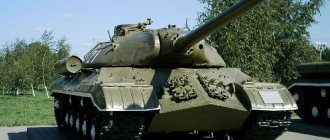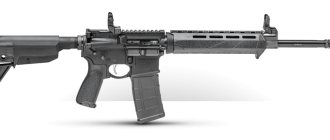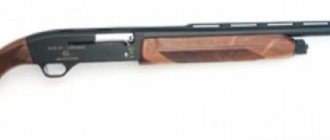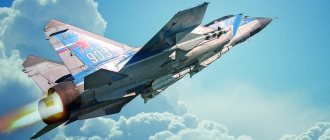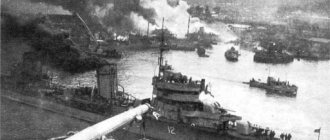Thompson submachine gun
(sometimes
a Thompson assault rifle
; in the Red Army of the interwar period it was sometimes classified as a light machine gun) - one of the first examples of hand-held automatic weapons that reached mass production.
And certainly the most large-scale of the pioneers (almost 2 million pieces). He is also “Tommy Gun”, “Lead Rain”, “Street Sweeper”, “Chicago Typewriter” and many more names. Thompson M1921 with 100-round drum magazine
(link)
Thompson submachine gun at GunsRoom
(link)
Thompson machine gun in games
| « | The weapon that made the Roaring Twenties roar[1]. […] Half sinner, half saint. Known by hundreds of names. Incredible weapon, hero of incredible stories. And the most interesting thing is that they are all true. Thompson submachine gun. | » |
| — Video about Thompson in games | ||
Device[edit]
General John Tagliaferro Thompson himself
invented little, but was able to combine several patents into a truly legendary cannon.
This is generally characteristic of good designers: “there are only seven notes,” and almost all the nodes were already known. Often inventors are generally worthless designers, poor Dardik is an example of this.
There is an invention, but what performance characteristics has it achieved? Thompson's PP operates on the principle of a semi-free bolt - that is, at the moment of firing the bolt is not engaged with anything, but is slowed down by some part (unlike machine guns and rifles, where it is wrapped on protrusions - a longitudinally sliding bolt with rotary locking
, and pistols, where nothing interferes with the bolt except its large mass and the return spring -
blowback
).
The Thompson SMG uses a semi-free shutter of the Blish system
[2] - an H-shaped insert made of another metal (bronze) runs in an oblique groove and gives a lot of friction during a shot. And when the pressure of the powder gases drops, friction decreases, and the bolt opens with ease.
In fact, the Blish system worked very poorly[3], and the largest cartridge for which it was possible to do something was the heavy pistol .45 ACP (11.43x23 mm, as in the Colt M1911)[4]. Hence the term submachine-gun,
- literally “under-machine gun”[5]. Some modifications (including the famous 1921 model) fired up to 900 rounds per minute - a bit too much.
The PP was equipped with a box magazine for 20 or 30 rounds, or a drum magazine for 50 or 100. The drum magazine was equipped as follows: remove the crank from the magazine, open the magazine and fill the spiral grooves with cartridges. After this, close the store, put the handle in place and start it - turn the handle 9...11 clicks. If you open a loaded magazine, you will get scattered cartridges and a strong blow to your hands from the spring. Work with the fuse and also charge the drum
only possible with the shutter retracted. It's kind of complicated.
The PPT fires from an open bolt, i.e., before the start of shooting, the initial position of the bolt is the rearmost position, after pressing the trigger, the cartridge is removed from the magazine, sent into the barrel and a shot occurs. This prevents the cartridge from “sintering” in the hot barrel. Also for this reason, there is no such error in the Thompson as leaving a cartridge in the chamber when unloading. (But there is another problem - spontaneous shots are frequent, so this scheme was abandoned after WW2.)
All Thompson's metal parts were milled, and all wooden parts were walnut. So this miracle cost 220 dollars in those days - about 2900 dollars in 2022[6]. Attempts to reduce the price did not bring much effect. The weight of an empty PP is 4.7 kg, and with a drum magazine - more than 7 kg! With such a colossus, the recoil from a powerful cartridge is simply not felt, but in fact, the range of actual fire did not exceed 100 meters.
Controls[edit]
(link)
Scheme of operation and internal structure of the Thompson submachine gun.
The cocking handle is on the top (in some versions on the right).
The safety and fire selector (two different levers) are located on the left above the pistol grip; they operate only when the bolt is retracted.
The magazine release lever is also on the left above the pistol grip.
Common mistakes[edit]
The weapons are rare and complex, few people even held a demilitarized model - it’s not surprising that the actors and animators made a lot of mistakes.
- Hold the Thompson PP by the drum. When firing, the crank shakes violently, and when the magazine is empty, it can slap your hands.
- Insert the drum
like a Kalash (hooked and latched) or like an M16 (from below). The drum slides in from either side along special grooves. The latch is located on the left. - Reload the drum
like a regular hammer-fired weapon (replaced - distorted).
You must first remove the bolt (and it remains there), then change the magazine. With a box magazine,
the situation is simpler - it is loaded from below in any position of the bolt, although if you don’t want the magazine spring to weaken prematurely, it’s better with it open. Modern self-loading replicas often fire from a closed bolt: this design is more common and does not allow accidental shots, for example, when falling. They are also much more difficult to convert into fully automatic, which is important for American legislation. - It's wrong to animate the charging handle. The Thompson fires from an open bolt, meaning a battle-ready SMG has this handle on the back. There is no bolt stop, and if you try to shoot with an empty magazine, the bolt moves forward and does not return. If you do not fire this blank shot (during single shooting or when the magazine is not completely used up), the handle is obviously at the back, and to reload it is enough to change the magazine.
- Recoil. Even in the 1928 version with a muzzle compensator, due to the unfortunate shape of the butt, the Thompson lifts up strongly when shooting. So even for a fairly experienced shooter, after pressing the trigger, the third or fourth rounds fly “into the sky” before he returns the weapon to the horizontal and begins to hold it there, and for new recruits, at least half a magazine will go well above the target.
- How much worse the 1942 Tommy is than its earlier versions is a debatable issue. However, comparing the effectiveness of old models in mafia showdowns (where the normal distance of fire contact is across the street) with the effectiveness of later ones on the battlefield (where the effective firing range of 100 meters raises the question “why is it so small?”, and the flatness of the trajectory of a heavy and slow bullet) At such a distance it makes it very difficult to aim) it’s clearly not worth it. Everything is learned in its place and in its time, and by the forties, the time of the “Tommigans”, alas, had passed.
What civilian variants did the machine gun have?
As you know, citizens of the United States of America have the right to freely bear arms.
Still, civilian weapons should have lower characteristics than military ones, so manufacturers have released several versions of sports and civilian assault rifles. True, they were renamed self-loading carbines.
Among them, the following models should be noted:
- M1927A1 - Thompson self-loading carbine, the bolt has undergone changes, as a result of which it has lost the ability to fire in bursts;
- M1927A3 is a self-loading sports carbine fired by twenty-second caliber. The weapon became lighter and was successfully used at the shooting range;
- M1927A5 is a self-loading carbine chambered for the standard Colt pistol cartridge. Some of the steel parts were replaced with aluminum, and the barrel was shortened by half (to 5 inches) so that the carbine met US requirements for conventional pistols;
- The Thompson 1927A was produced in 2008 in a small batch, without a stock, with a barrel length of 266 millimeters, but with a disk magazine for fifty rounds.
A little history[edit]
John Blish noted: piston (that is, screwed onto a thread) bolts of naval guns hold well if a lot of caps (bags of gunpowder) are stuffed into the barrel, but they open spontaneously if there is not enough gunpowder - this is how the frictional force between two different metals acts unusually. Instead of a screw, he proposed using an inclined plane (US patent 1915).
General Thompson was solving a specific WW1 army problem - how to equip assault groups to effectively clear enemy trenches. He himself was unable to curb the recoil, and then Blish’s patent turned up. Together with businessman Thomas Ryan, they formed the Auto-Ordnance
, and development began to boil.
But the authors were late: the first batches of “Annihilator” arrived
right in time for the final analysis of the Compiegne Agreement (1918).
Serially produced in five versions:
- The M1921 is the most famous model, used by both gangsters and special police forces. The 1926 version was called the M1921AC and had a Cutts muzzle compensator.
- M1923 - an unsuccessful attempt to sell PP to the military. They strengthened the cartridge and reduced the rate of fire to 400 rds/min, but the military was not impressed with the design.
- M1928 is a naval model that, with a weighted bolt, reduced the rate of fire to 600 rounds per minute.
- M1928A1 is a greatly simplified (but still very expensive) military model. A decent number of machine guns came under Lend-Lease to the USSR, but they were not very popular in the Red Army.
- The M1 is an exclusively military model, developed in 1942 by Savage Arms for the Department of Defense. The simplest and coolest variation of the old Tommy: the possibility of using drum magazines was removed, the barrel lost its cooling ribs, the semi-free bolt gave way to a free one, and its handle moved to the right side of the receiver. The M1A1 modification also lost the trigger in the trigger and the single-fire mode.
1920s. Take another look at the technical specifications, price and ease of use. Not surprisingly, the military was not impressed with the PP. But the PP was also sold on the civilian market, and for this Thompson came up with a new name for the weapon - “submachine-gun ”
).
Not as frightening as the “Destructor”, but speaking of its incredible power. True, it was extremely expensive (see above). And then Prohibition struck, and the cards went! Modern self-loading versions of the Thompson from Auto-Ordnance
Look at the characteristics again. Thanks to the milled design and high-quality wood, it has a sophisticated look, like a musical instrument. With a short length and semi-disassembled, it fit into a violin case. Price is not an issue for a gangster, and even “the smarter the better.” Huge firepower at distances of up to 50 meters made the PP a favorite weapon of gangster wars. To beat gangsters armed with heavy guns, Auto-Ordnance
sold PP to newly formed special police units.
By the way, Cutts's compensator appeared on the Tommy Gun due to experience, including criminal showdowns. According to legend, the great and terrible Al Capone sent a subordinate to eliminate a competitor. He waylaid him on the street and from about 7 yards (about 6 meters) fired a whole drum of 50 rounds. Never hit! True, citizen Capone’s competitor fled the city and never returned, so we can say that the elimination was a success. But similar precedents (I believe there were also complaints from the police) required somehow reducing the tossing of weapons during shooting. As a result, the PP was equipped with a compensator.
By 1930, the fashion for the “cool film” had begun, and Thompson, with his short length and recognizable silhouette, fit well into the frame.
With the fall of Prohibition, the need for such powerful weapons disappeared. But Auto-Ordnance
saved naval orders. On the cultural side, in 1934 the purchase of such powerful guns became more difficult, and the Hays Code came into effect, banning anti-heroes from “cool films.”
When WW2 hit, they tried to make the PP cheaper, but the results were poor. But still, 1.5 million pieces were stamped. Immediately, counter-propaganda arose depicting America as a pack of Thompson bandits. This did not hit the USA at all - the image of the criminal was too romantic. In addition, the design and silhouette of the PP were changed to suit military needs: the Blish bolt was replaced with a completely free one, the carved handle with a dull fore-end, the folding sight with an L-shaped one, and the drum loading was removed. Subsequently, the Thompson began to be replaced by the M3 “Oil Can” - an ordinary military ersatz, without any elegance or style, but more reliable and cheaper.
Under the Lend-Lease program, Tommy guns were also supplied to the USSR (both together with American tanks and separately). He did not win much love among the Red Army soldiers: in his memoirs, both unconditional shortcomings (heavy weight, poor balance, difficulty of maintenance in the field) and relative ones (short range of effective fire), and even completely far-fetched ones (like the inability to penetrate a pair of quilted jackets) are noted ). According to the results of field tests, the Thompson was recognized as inferior in combat qualities to the domestic PPSh, and it was recommended to refuse orders for it in favor of Colt M1911 pistols. However, Thompson PPs delivered to the Union were used to protect rear warehouses and airfields. In general, in those places where ammunition consumption was scanty and the use of non-standard ammunition did not complicate logistics. Only the Marines of the Northern Fleet enjoyed a certain respect for machine guns.
British commandos, on the other hand, had great respect for the Tommy Gun. Considering the fighting qualities of a “plumber’s dream” (which is “STAN”), it’s not surprising.
Tommy received the greatest recognition in China: the M1921 was highly appreciated by the local military, but the Chinese did not want to buy “golden” submachine guns overseas. Technical documentation was purchased relatively inexpensively, and already in 1923 production began on its own. Chinese Thompsons were produced until the second half of the 1940s by at least two enterprises, and a considerable part of them were chambered for the 7.63x25 Mauser cartridge. Submachine guns of later releases used a standard magazine from the Soviet teaching staff[7].
In 1960, the Hays Code fell, and a new wave of crime films began (Bonnie and Clyde, The Godfather).
The fashion for war shooters that emerged in the early 2000s drove Tommy crazy. A rarer and more interesting role is that of a random person (Fallout) or a strange anachronism (BioShock).
Auto-Ordnance Company
still active today (2020) as part of
Kahr Arms
. It produces replicas, but only in a self-loading version and firing from a closed bolt - this design is more common and more difficult to convert into automatic.
How the machine gun was used after the war
Although the Thompson submachine gun proved to be somewhat outdated in the Second World War (large mass, technological complexity of processing), many submachine guns were manufactured, and there was no full-fledged replacement.
This weapon was loved by ordinary soldiers and special service soldiers. Therefore, the Tommy Gun remained in service until the mid-1970s; the final replacement occurred with the mass production of M-16 assault rifles.
It was actively used in the Korean War 1950-53. During the civil war in Vietnam, Thompsons were mainly used by South American soldiers, and in American units they were used by special forces groups.
The last real use of the Tommy Gun in combat conditions by army units was recorded during the Balkan troops of the nineties of the last century.
However, one should not think that the machine gun is no longer used in combat - it is still found in local civil conflicts in third world countries.
Where it occurs[edit]
Terminology[edit]
- In old English-Russian dictionaries (well, as old as the 1976 edition), the English equivalent of the term “machine gunner” was “tommy-gunner”. Such is the echo of the “roaring twenties”.
Folklore[edit]
- An anecdote about a boy who confused the violin cases with his father: “What will dad do with my violin in a jar?”
Literature[edit]
- Larry Correia, Monster Hunter Alpha - Harbinger carries this submachine gun loaded with silver bullets. He is a werewolf himself, so the weight of the Tommy gun is insignificant for him.
Cinema[edit]
- "Scarface" 1932 - Possibly first appearance.
- "The Godfather" and other films about the mafia.
- "Lone Hero"
- "Legends of Autumn" - flashes at the end of the policemen
- "Johnny D"
- “Only girls in jazz”!
- “Bonnie and Clyde” 1967 - the title characters use Tommy guns with all their might, and then they themselves are sent to the next world with the participation of these weapons, among other things. In reality, Clyde Barrow preferred the Browning M1918, stolen from the National Guard arsenal.
- "Mask"! GG scares the gopniks with a “Thompson”, which he made himself from a balloon using the magic of a mask
. - Snatch - Tommy (nicknamed "Tits") tells everyone that his parents named him after the subject. However, his childhood friend Turetsky knows that in fact it is “in honor of some ballet dancer”
- “Bugsy Malone” - cream guns that provided an advantage in the conflict of one of the mafia groups, look like “Thomson”. It’s understandable - this is a children’s (in every sense, the actors are children too!) parody of the “gangster movie.”
- The combat film collection “Young Partisans”, the short story “Teacher Kartashova” - Tommy appears in an extremely atypical role: he portrays German weapons. If you look closely, you will notice that the German helmet of its owner is not entirely German: it is depicted in a fairly authentically converted Soviet steel helmet SSh-36. The answer is simple: the short story was filmed in 1942 at the Soyuzdetfilm studio (temporarily merged with Tajikkino), which had just been evacuated to Stalinabad, and the necessary props were simply not found.
- “Podolsk cadets” - the head of the intelligence school, Starchak, is armed with a Thompson.
- Aliens - The M41 Pulse Rifle is a camouflaged military-issue Thompson. Four rifles (according to other sources, six) were able to shoot, one - both from the main barrel and from the grenade launcher (which served as the sawn-off shotgun). There are kits for converting an airsoft Thompson into an M41.
- "The Mummy: Tomb of the Dragon Emperor" - "Welcome to the 20th century!" But O’Connell’s son preferred the “weapon of the future” - our native PPS-43.
TV series[edit]
- "Boardwalk Empire" - Nucky Thompson sells Tommy guns to the Irish Republican Army. At the same time, one of the Irish asks whether the machine gun was named after Nucky Thompson himself?
- Band of Brothers
- “Terminator: The Sarah Connor Chronicles” is a filler about a terminator who, due to a software error, was moved in time a hundred years earlier than expected, and was forced to integrate into society to complete his task. He integrated himself as an entrepreneur and a gangster (you have to get money for a business from somewhere!). One-handed shooting of the Tommy (infrequent, it must be said: M1921) is included.
Anime and Manga[edit]
- Upotte!! — Thompson-sensei supervises the junior high school girls[8] and is the local Miss Fanservice because he has a large... store capacity.
- JoJo's Bizarre Adventure - Joseph used it to shoot Straits, who had accepted vampirism.
Video games[edit]
- Shooter about WW2. Anywhere there is the USA.
- Naturally, in a bunch of games about the mafia like the trilogy of the same name. The reel option often embodies cool practicality and is actually a symbol of the game.
- BioShock
- Fallout 2 - Many gang members in New Reno are armed with it. A very good weapon for the mid game. Also present in Fallout Tactics. And in Fallout: New Vegas and Fallout 4 there is a .45 caliber submachine gun, apparently also based on the Tommy gun, but unnamed. New Vegas also has the RSW laser, which is based on the Tommy gun but shoots a laser.
- Not good with guns - while the M1 uses standard .45ACP ammo, the M1928 requires its own - the exotic .45Thompson used only for this weapon. Of course, IRL both SMGs were chambered for the same ammunition.
Visual novels[edit]
- THE DELUCA FAMILY - the protagonist has a tomigan on the screensaver
Music[edit]
- Warren Zevon - Roland the headless Thompson gunner
[edit] Excursion into history
The idea of a submachine gun may have captured the minds of designers even before the First World War. But only at the height of the all-European meat grinder SUDDENLY it became clear: it was necessary without any restrictions to produce something faster than some three-line rifle. The Maxim machine gun was extremely heavy (how else could one be chained to it?) and cumbersome. Something more kosher was needed. The first were the Italians with their truly gloomy Revelli, then there was Fedorov with his epic but underrated machine gun, and finally in Germany, just before the end of the war, Schmeisser Jr. came up with the MP-18.
Models[edit]
- The first prototype of 1919
- Second prototype of 1919
- Thompson M1921 with Cutts compensator, assembled on
- Thompson M1928
- Thompson M1928A1
- Thompson M1
- Thompson M1A1 - simplified version of the Second World War
- Thompson M1923 - prototype tested as a promising light machine gun.
- One of the prototypes of an automatic rifle chambered for .30 Carbine
- Version with integrated silencer for WWII Australian SAS
- A copy of the Thompson, assembled at the Shanxi Arsenal during the war with Japan.
- The Thompson version, produced at the Birmingham Arsenal in the 30s. Cartridge - 9x19 "Parabellum".
What were the main modifications and their performance characteristics?
Despite a significant number of different modifications, Thompson submachine guns had quite a lot in common. First of all, this is the bolt group, which has remained virtually unchanged during numerous alterations and simplifications.
The second is caliber. SMG Thompson - for army units it was produced only in .45 caliber.
During production, the barrel length and finish changed, the magazines changed, from 100-round “pancakes” to short 20 local magazines. The receiver also changed, its production was simplified, and the sighting devices were simplified.
| Model | Weight, g | Length, mm | Rate of fire in min | Shop |
| M1919 | 3750 | 808 | 1500 | disk 100 |
| M1921 | 4690 | 830 | 900 | box-shaped for 20/30 cartridges, disc 50/100 |
| М1928А1 | 4900 | 852 | 900 | box-shaped for 20/30 cartridges, disc 50/100 |
| M1 and M1A1 | 4780 | 811 | 900 | box-shaped for 20/30 rounds |
[edit] See also
- PPSh
- Ultrasound
| [ + ] Bullet is a fool, Thompson is great! | |||||||||||||||||||||||
| |||||||||||||||||||||||
